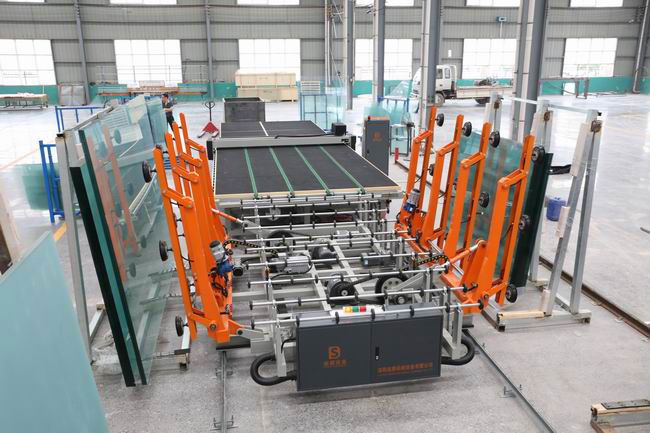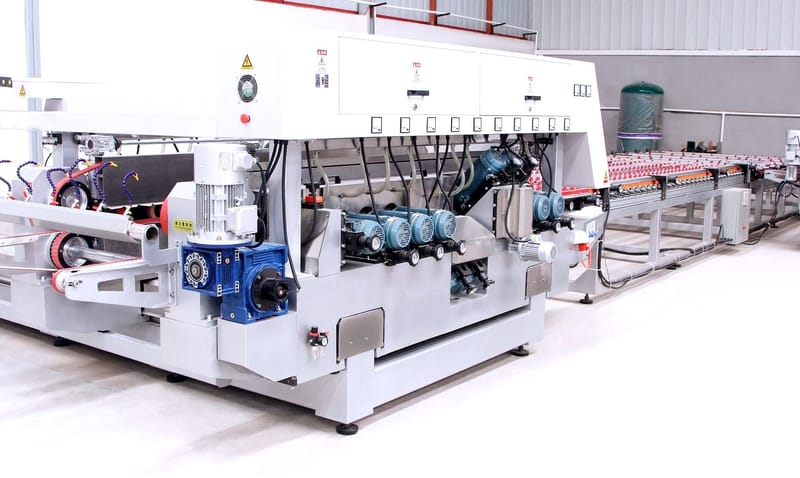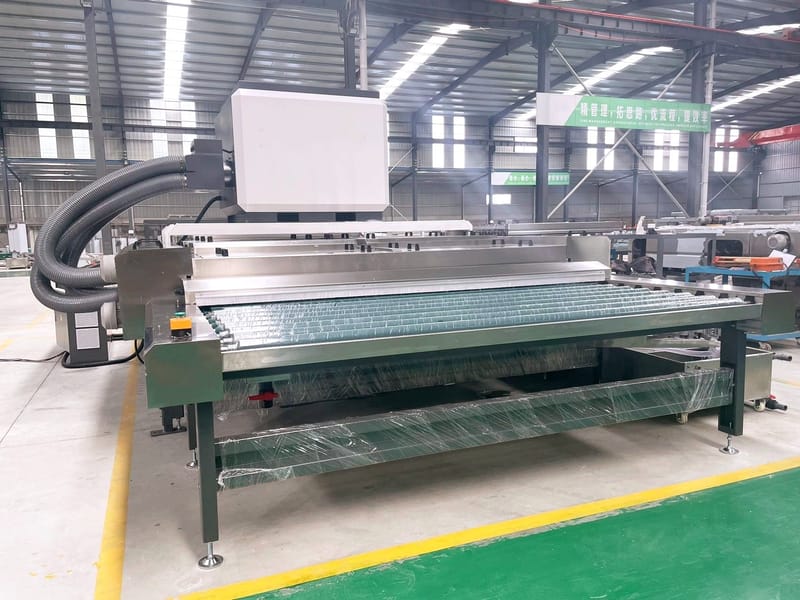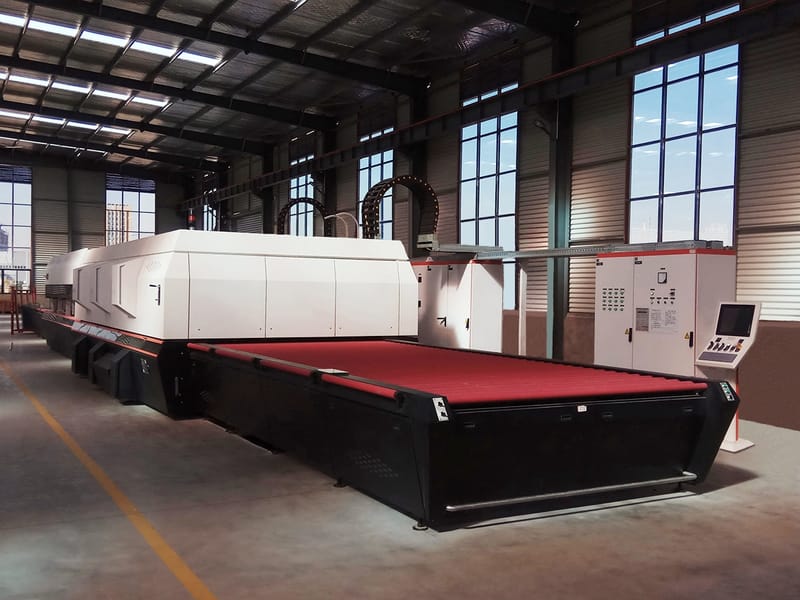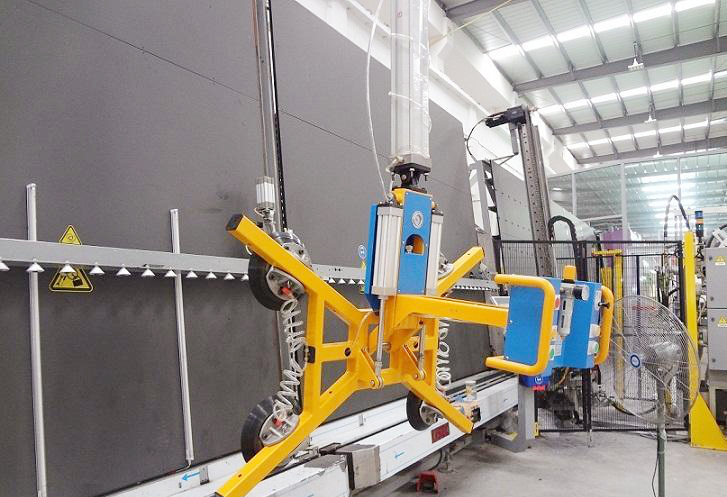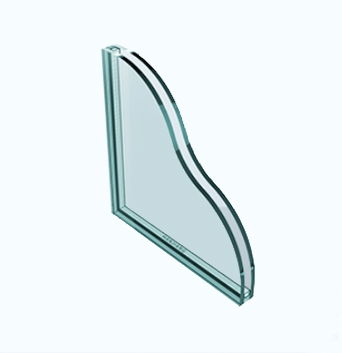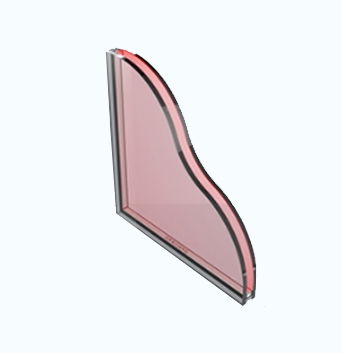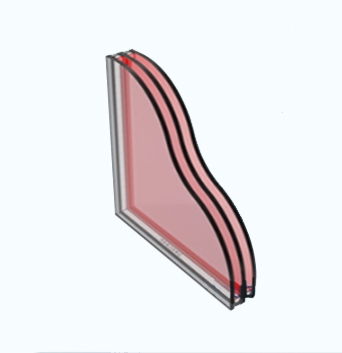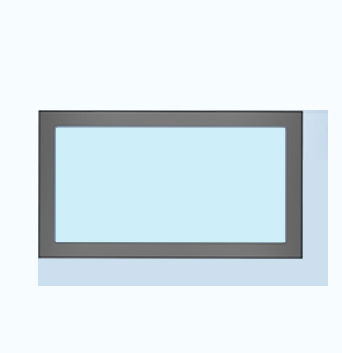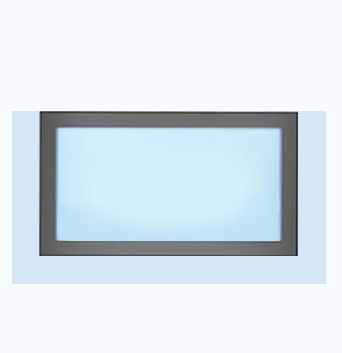Manual de usuario
All types of insulating glass machines for beginners&professionals.
Pick your first insulated glass machines for automation factory glass industry manufacturing.
Tempered insulating glass is a glass product that uses an aluminum frame or extruder strip injected with desiccant to separate the glass between two or more pieces of tempered glass, and is sealed on all sides by sealing to keep argon-gas filling in the middle cavity at all times.
- Principle of tempered homogenization treatment
- Process of tempered homogenization treatment
1. Heating stage
The heating stage starts at the ambient temperature of all glasses and ends when the surface temperature of the last glass reaches 280℃. The temperature in the furnace may exceed 310℃, but the temperature of the glass surface cannot exceed 320℃. The time when the glass surface temperature exceeds 300℃ should be shortened as much as possible.
2. Insulation stage
The insulation stage starts when the surface temperature of all glasses reaches 280℃, and the insulation time is at least 2h. During the entire insulation stage, the temperature of the glass surface should be kept within the range of (290±10)℃.
3. Cooling stage
When the glass that finally reaches 280℃ has been kept warm for 2h, the cooling stage begins, during which the glass temperature drops to the ambient temperature. When the temperature in the furnace drops to 70℃, the cooling stage is considered to be terminated.
¿Cómo elegir el equipo de producción de vidrio templado adecuado?
Tempered glass production equipment mainly includes a glass loading and transport equipment, glass cutting machine, glass edge grinding machine, glass washing and drying machine, double-chamber tempering furnace and so on. However, How to pick the appropriate tempered glass production equipment? What kinds of suggestions LIJIANG Glass could offer you, Maybe that is the key-point you got.
Equipo de carga de láminas de vidrio
Glass Cutting Machine
El puente de corte está hecho de metal rígido y antitorsión y es accionado por un servomotor a través de un dispositivo de transmisión preciso. Los movimientos del cabezal de corte incluyen X/Y/Z y rotación del cabezal. La altura y la presión del cabezal de corte deben ajustarse automáticamente de acuerdo con la situación del vidrio, y el aceite de corte se inyecta automáticamente en la rueda de corte.
El cabezal de extracción de película y el cabezal de corte comparten un marco de puente. La rueda de extracción de película es impulsada por un motor y tiene un dispositivo de extracción de película y de eliminación de polvo. La altura de la rueda de extracción de película se puede ajustar automáticamente de acuerdo con el tamaño de la muela de pulido y el espesor del vidrio, y la presión de extracción de película se puede ajustar automáticamente. La máquina de corte puede detectar automáticamente el tamaño y el espesor original del vidrio e identificar con precisión su posición.
Rectificadora de bordes de vidrio
Lavadora y secadora de vidrio
1. Conveying system
The conveying system adopts rubber roller conveying.
2. Inlet segment
The inlet segment is an independent frame with a pre-rinsing part on it, protective covers on both sides of the inlet segment (the protective covers are carbon steel protective covers, painted), and a water accumulation tray on the inlet segment to ensure that the rubber roller at the inlet end is immersed in water for 10 mm to achieve the self-cleaning effect of the rubber roller.
3. Washing segment
The cleaning segment has four sets of brushes, and the water sprayed from the nozzle can form a fan shape. The cleaning part includes the pre-rinsing part, which uses a water pipe with a flat nozzle.
4. Air-drying segment
The air-drying segment has three pairs of air knives, each pair of air knives has upper and lower air knives, and the air knives are made of stainless steel. The height of each air knife can be adjusted manually separately, and there are steel plates and sound insulation cotton inside the air-drying segment for sound insulation.
5. Outlet segment
The outlet segment is an independent frame with three sets of inspection lights on it, and protective covers on both sides of the outlet segment, which are carbon steel protective covers, painted.
6. Wind system
The fan is installed in a soundproof box, and the soundproof box is surrounded by soundproof cotton and porous plates, which can achieve the effect of sound insulation. The soundproof cotton is protected by porous plates to prevent dust from contaminating the fan.
7. Water system
The water tank is installed under the shelf, and a water tank in the pre-rinsing part can use clean tap water. The cleaning section is equipped with an integral water tank with casters and handles, which can be freely dragged out for cleaning.
8. Electrical control system
The electrical control system includes a control cabinet installed near the outlet of the equipment.
Horno de templado de vidrio de doble cámara
① The glass is evenly arranged in the upper section;
② It is sent to the heating furnace for uniform heating, and then sent to the wind grid section for rapid cooling after heating to complete the tempering;
③ It is transported to the lower section and the lower piece is packed manually. The double-chamber tempering furnace is mainly composed of a film-placing table, a preheating furnace, a heating furnace, a cooling device, a film-unloading table, a wind duct system, and an electrical control system.
1. Sheet placement table
The original glass is placed on the sheet placement table in a certain way. After pressing the start button, the roller starts to move forward with the glass. After triggering the photoelectric switch near the transition roller, the roller stops rotating and the glass waits for the next command here.
2. Preheating furnace
The preheating furnace adopts upper forced pure convection technology. When the glass enters the preheating furnace, the door of the preheating furnace is opened, and the sheet placement table conveying roller and the ceramic roller in the preheating furnace rotate synchronously to send the glass into the preheating furnace. Then, the preheating furnace closes the furnace door. The glass is driven by the roller in the preheating furnace and reciprocates within the set range. The glass is heated quickly and evenly, and the heating quality is better than other methods. At the same time, it can ensure that the ceramic roller does not bend or deform, extending the service life of the preheating furnace.
3. Heating furnace
The performance and configuration of the heating furnace are the same as those of the preheating furnace, that is, the upper forced pure convection technology.
4. Cooling device
The cooling device is composed of a cooling air grille and a conveying roller.
5. Lower sheet table
The lower sheet table is a horizontal roller section with heat-resistant imitation rope wrapped on the surface.
6. Air duct system
The air duct system is mainly composed of fans, air supply pipes, and air collecting boxes.
7. Electrical control system
The electrical control system mainly includes the host computer, PLC system, variable frequency drive system, fan inverter system, and heating control system.
How to produce the insulating glass units by Automatic Solution
1. Bending of aluminum spacers: First, cut and bend the aluminum spacers into a shape of appropriate size according to the glass processing size requirements. This step is usually completed by automated bending equipment to improve production efficiency and reduce manual errors. At the same time, laser coding can be performed according to the OA work order system to identify the model.
2. Filling of aluminum spacers: After the aluminum spacers are bent, the aluminum spacers are filled with adsorbents. Generally, a 3A molecular sieve is used as the adsorbent for filling.
3. Low-E film layer detection: The film layer is detected through the Low-E Glass photoelectric detection switch in the feeding section to effectively prevent the Low-E Glass from being placed upside down.
4. Washing and Drying: The cut glass blocks will go through the cleaning process to remove dirt, grease, and other impurities on the surface to ensure that the next process can proceed smoothly. Glass washing usually uses an efficient washing and drying machine, which can complete the cleaning of large quantities of glass in a shorter time.
5. Inspection: The washed glass blocks need to undergo strict quality inspection to ensure that they meet the standards and requirements. The inspection process is usually carried out by manual visual observation, which can detect the flatness, thickness, surface defects, and whether the glass is clean.
6. Assembly: The glass blocks that have passed the inspection will be sent to the insulating glass plate pressing segment for assembly. The insulating glass machine will automatically place two or more pieces of glass at the required interval and inflate them.
7. Sealing: The assembled glass undergoes a sealing process to ensure that the gas or air in the insulated layer does not leak. Sealing generally uses high-efficiency sealants, such as hot melt sealant or structural sealant, and fully automatic sealing lines for sealant application.
8. Inspection: Finally, the insulating glass is inspected again to ensure that the quality and performance meet the requirements. For example, glass appearance inspection, sealing test, thermal performance test, etc. can be carried out.
Know More
- Assemble the Aluminum Spacer Strips
- Apply the Butyl Extruder Coating
- Check Frame Sealing and Glass Plate Pressing
- Automatic Sealing
Solución automática de procesamiento de vidrio aislante
In case you are looking for a trusted manufacturer & brand to purchase your next automatic insulating glass processing solution at an affordable prices & high-quality components, LIJIANG Glass can be an excellent place to rely your trust on, and meet the above insulating glass produce requirements.
El sistema inteligente de clasificación y almacenamiento de vidrio LIJIANG Glass se puede conectar a la mayoría de los software ERP del mercado. Se puede utilizar fuera de línea con carga y descarga automática de películas, o se puede conectar a una línea de producción de vidrio aislante para formar una conexión automatizada. El equipo puede detectar automáticamente el tamaño del vidrio o leer directamente el código que identifica el tamaño del vidrio y se puede emparejar y clasificar según el tamaño. Puede emparejar y distinguir vidrio doble, vidrio triple, vidrio cuádruple, vidrio laminado, vidrio Low-E, vidrio esmerilado, vidrio revestido y otros vidrios. Se puede dividir en pedazos según los clientes. Se puede dividir en piezas según la tarjeta de proceso y la tarjeta de proceso se puede imprimir después de colocar las piezas.
Conozca más detallesLa línea de producción de prensado de doble placa y doble llenado de vidrio aislante LIJIANG Glass, que incluye una sección de alimentación, una sección de lavado y secado, una sección de lavado y descarga, una sección de almacenamiento, una sección de inspección y enmarcado, una sección de alimentación de prensado plano, una sección de prensado de placa inflable y una sección de descarga de prensado plano. La sección de prensado de placas inflables incluye una placa móvil frontal, una placa fija trasera, placas de sellado izquierda y derecha, una cinta transportadora y un mecanismo de inflado. La sección de prensado de placas inflables puede inflar y presionar dos piezas de vidrio de menos de 3 metros de largo al mismo tiempo según sea necesario, o presionar una placa de vidrio extra grande.
Conozca más detallesLa máquina extrusora de recubrimiento de butilo para vidrio aislante fabricada por LIJIANG Glass puede ajustar rápidamente la distancia entre los dos cabezales recubiertos para adaptarse a diferentes especificaciones de tiras espaciadoras de aluminio. Incluye un marco y dos sistemas de sellado independientes. Cada sistema de sellador incluye un cilindro de extrusión de sellador y el cabezal de sellador está fijado con respecto al cilindro de extrusión de sellador. Los dos cabezales selladores se yuxtaponen a cierta distancia para recibir el espaciador de aluminio y aplicarle un recubrimiento de extrusión de butilo. El marco está provisto de un lugar para que uno de los sistemas de recubrimiento se mueva. El riel guía se usa para ajustar la distancia entre los dos cabezales revestidos, y también hay un dispositivo móvil que impulsa el sistema de recubrimiento para que se mueva a lo largo del riel guía.
Conozca más detallesDada la gran cantidad de vidrios revestidos, como el vidrio revestido de baja emisividad y las películas de control solar, que se utilizan en el mercado actual de procesamiento de vidrio aislante, se deben eliminar varias películas alrededor del vidrio recubierto de butilo; de lo contrario, la vida útil del vidrio aislante se verá afectada. . En términos generales, la primera opción es la eliminación mecánica de la película de la superficie del vidrio. Los parámetros recomendados para la rueda de eliminación de película de la máquina selectora de eliminación de película de vidrio de baja emisividad automática LIJIANG Glass son presión de aire de 0,8 MPa ~ 1,2 MPa, velocidad de rotación de 1800 ~ 1900 r/min; la muela abrasiva está hecha de esmeril o alambre de acero inoxidable debajo 0,15 mu (malla 100). Después de retirar la película no quedan rastros en la superficie. La dirección del desarrollo es configurar muelas abrasivas de acuerdo con diferentes sistemas de película.
Conozca más detallesLa línea de robots selladores de vidrio aislante LIJIANG adopta un sistema de control de interfaz hombre-máquina con pantalla táctil grande para realizar el posicionamiento automático de marcos divisorios de aluminio, elevación y descenso automáticos de prensado, transporte, recubrimiento de sellador, calentamiento automático por sincronización y otras funciones. El equipo adopta tecnología avanzada de refuerzo de gas-líquido para hacer que la presión del sistema sea más estable y ahorre energía. El sistema está equipado con un sistema de alarma por falta de sellado y una configuración de suministro de doble grupo y doble sellado. La producción no se retrasará durante el reemplazo del sellador. El cabezal de sellado es ajustable dentro del rango de 6 a 20 mm y se puede ajustar hacia arriba y hacia abajo.
Conozca más detallesLa máquina dobladora de tiras de aluminio para vidrio aislante de alta precisión LIJIANG Glass incluye un mecanismo de transmisión y un mecanismo de doblado. El mecanismo de transmisión incluye una rueda motriz, dos ruedas fijas y dos cadenas de transmisión; las dos ruedas fijas se cargan en dirección horizontal a través de una cadena de transmisión conectada dinámicamente; la rueda motriz está conectada motrizmente a una de las ruedas fijas a través de otra cadena de transmisión; el mecanismo de doblado incluye una rueda de presión giratoria y un dispositivo de ajuste de altura; la rueda de presión y las dos ruedas fijas están situadas en el mismo plano vertical, y situadas por encima del centro de las dos ruedas fijas; el dispositivo de ajuste de altura se instala encima de la rueda de presión y adopta una estructura de tornillo para ajustar la altura de la rueda de presión con alta precisión.
Conozca más detallesLa máquina llenadora de tamiz molecular de vidrio aislante LIJIANG Glass tiene un marco de soporte instalado fijamente en el medio de un lado del cuerpo principal. Por encima del marco de soporte está fijada simétricamente una pistola de llenado. Un asiento fijo está soldado a la parte superior y media del marco de soporte. Se instala de forma fija una base fija en el medio del extremo frontal de la base fija. El marco de fijación tiene ranuras de fijación en el medio de ambos lados del marco de fijación. Una varilla de empuje en forma de L se puede mover dentro de la ranura de fijación. Se instala una placa de presión móvil en un lado de la superficie exterior de la varilla de empuje en forma de L. Este equipo evita que la pistola de llenado empuje el espaciador de aluminio hacia arriba y hacia abajo durante el llenado, mejora la estabilidad general del espaciador de aluminio durante el llenado y, por lo tanto, mejora la eficiencia general del llenado del espaciador de aluminio.
Conozca más detallesEsta mesa de sellado de sellador giratoria de vidrio LIJIANG adopta una estructura de rotación hacia adelante y hacia atrás y puede operarse libremente. Todo el equipo está hecho de tubos cuadrados soldados con alta resistencia y no es fácil de deformar. Las válvulas de pie de elevación, descenso y rotación se controlan individualmente con autobloqueo para reducir el mal funcionamiento. El vidrio aislante con diferentes especificaciones se puede utilizar de forma flexible y cómoda.
Conozca más detallesLa bomba principal del equipo aplicador manual de sellador de dos componentes LIJIANG Glass es accionada suavemente por el sistema hidráulico; el sistema de trayectoria del sellador del agente de curado completamente cerrado evita que el agente de curado entre en contacto con el aire y se solidifique; la estructura dosificadora de dos componentes se ajusta continuamente para cumplir con los requisitos de dosificación precisos; Adopta un mezclador alternativo estático internacionalmente popular, que se mezcla de manera más uniforme.
Conozca más detallesEl congelador con pistola selladora de vidrio aislante LIJAING Glass incluye una carcasa de caja, un tanque de aislamiento de baja temperatura, un tanque de aislamiento de alta temperatura, un compresor y un ventilador instalados en la pared de la carcasa. El tanque de aislamiento está conectado al compresor a través de una tubería y la parte superior de la carcasa está equipada con una tapa para garantizar la estabilidad de la temperatura a largo plazo de la pistola selladora.
El equipo inflador de gas inerte para vidrio aislante LIJIANG Glass se utiliza para inyectar gas inerte dentro del vidrio aislante para mejorar el aislamiento térmico, el sellado, el aislamiento acústico, el ahorro de energía y otras propiedades del vidrio aislante. Utiliza un analizador de pureza de gas importado de Estados Unidos y un sensor de gas importado de Japón para garantizar la estabilidad del inflador. El diseño de apariencia humanizada hace que el equipo sea hermoso y fácil de operar. Actualmente es el equipo hinchable de vidrio aislante más avanzado.
Conozca más detallesEste equipo es el vínculo entre la máquina extrusora de recubrimiento de vidrio aislante de butilo y la línea de producción de vidrio aislante. El equipo transportador colgante de marco de aluminio para vidrio aislante LIJIANG Glass LJSK02 es un equipo especial para después de almacenar y transportar el marco de aluminio recubierto con sellador mediante la máquina extrusora de recubrimiento de butilo durante el proceso de producción de vidrio aislante.
Conozca más detalles¿10 años?...
- The professional market analysis should be the first step.
- A feasibility report should be done with the labor cost, material cost, factory cost and consumptions, productivity, etc.
- Accurate company management structure and system design.
- Professional machinery plan and software setup.
- All the targets can be achieved, tracked, and monitored accurately if the above jobs are professionally done …
The louver is completely sealed inside the insulated glass louver, and the lifting and turning of the louver are controlled by the magnetic force outside the glass or a remote control. The structure is reasonable and simple, and the operation is convenient, which saves space and inconvenience, and completes the thermal insulation of the insulated glass and the sunshade of the louver. It can easily adjust the indoor light environment and is suitable for various energy-saving building exterior doors and windows. It meets our energy-saving and environmental protection requirements, and is also very fashionable and beautiful. The insulated glass louver glass mainly controls the loss of indoor heat energy to the outside by reducing heat energy and convection, and completes its insulation function with a lower heat transfer coefficient.
LIJIANG Glass Automatic Insulated Glass Louver Curtain machine is a new generation of products designed specifically for processing aluminum louvers. It is controlled by CNC technology. The length, hole spacing, and number of punching holes are input through the touch screen. It automatically completes functions such as arc pressing, punching, cutting, counting, and ladder threading, with a high degree of automation. There are 12.5, 15, 16, 25 and other specifications to choose from. It is the main equipment for producing louvers, hollow louver glass and louver partitions.
Features & Advantages:
- It can automatically feed, press arcs, punch holes, cut, and discharge materials according to parameters such as the length, number of holes, and hole spacing of the curtain piece, and has alarm and shutdown protection functions.
- It has the function of automatically threading the ladder rope, saving labor.
- PLC control, touch screen setting, easy adjustment, high precision.
Technical Parameters:
- Machine power: 1.5kw 220v 50hz
- Applicable curtain width: 12.5mm, 15mm, 16mm, 25mm
- Overall size: 3800mm*500mm*1400mm
- Weight: 300kgs
